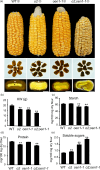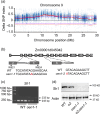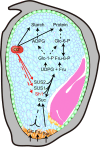Transactivation of Sus1 and Sus2 by Opaque2 is an essential supplement to sucrose synthase-mediated endosperm filling in maize
- PMID: 32004404
- PMCID: PMC7415785
- DOI: 10.1111/pbi.13349
Transactivation of Sus1 and Sus2 by Opaque2 is an essential supplement to sucrose synthase-mediated endosperm filling in maize
Abstract
The endosperm-specific transcription factor Opaque2 (O2) acts as a central regulator for endosperm filling, but its functions have not been fully defined. Regular o2 mutants exhibit a non-vitreous phenotype, so we used its vitreous variety Quality Protein Maize to create EMS-mutagenesis mutants for screening o2 enhancers (oen). A mutant (oen1) restored non-vitreousness and produced a large cavity in the seed due to severely depleted endosperm filling. When oen1 was introgressed into inbred W64A with a normal O2 gene, the seeds appeared vitreous but had a shrunken crown. oen1 was determined to encode Shrunken1 (Sh1), a sucrose synthase (SUS, EC 2.4.1.13). Maize contains three SUS-encoding genes (Sh1, Sus1, and Sus2) with Sh1 contributing predominantly to the endosperm. We determined SUS activity and found a major and minor reduction in oen1 and o2, respectively. In o2;oen1-1, SUS activity was further decreased. We found all Sus gene promoters contain at least one O2 binding element that can be specifically recognized and be transactivated by O2. Sus1 and Sus2 promoters had a much stronger O2 transactivation than Sh1, consistent with their transcript reduction in o2 endosperm. Although sus1 and sus2 alone or in combination had no perceptible phenotype, either of them could dramatically enhance seed opacity and cavity in sh1, indicating that transactivation of Sus1 and Sus2 by O2 supplements SUS-mediated endosperm filling in maize. Our findings demonstrate that O2 transcriptionally regulates the metabolic source entry for protein and starch synthesis during endosperm filling.
Keywords: Sh1; Sus1; Sus2; O2; Quality Protein Paize; endosperm; starch; storage protein.
© 2020 The Authors. Plant Biotechnology Journal published by Society for Experimental Biology and The Association of Applied Biologists and John Wiley & Sons Ltd.
Figures






Similar articles
-
The transcription factors ZmNAC128 and ZmNAC130 coordinate with Opaque2 to promote endosperm filling in maize.Plant Cell. 2023 Oct 30;35(11):4066-4090. doi: 10.1093/plcell/koad215. Plant Cell. 2023. PMID: 37542515 Free PMC article.
-
Genetic evidence that the two isozymes of sucrose synthase present in developing maize endosperm are critical, one for cell wall integrity and the other for starch biosynthesis.Mol Gen Genet. 1998 Jul;259(1):88-96. doi: 10.1007/s004380050792. Mol Gen Genet. 1998. PMID: 9738884
-
The three maize sucrose synthase isoforms differ in distribution, localization, and phosphorylation.Plant Cell Physiol. 2006 Jul;47(7):959-71. doi: 10.1093/pcp/pcj068. Epub 2006 Jun 7. Plant Cell Physiol. 2006. PMID: 16760218
-
Sucrose-associated SnRK1a1-mediated phosphorylation of Opaque2 modulates endosperm filling in maize.Mol Plant. 2024 May 6;17(5):788-806. doi: 10.1016/j.molp.2024.04.004. Epub 2024 Apr 13. Mol Plant. 2024. PMID: 38615195
-
Maize opaque mutants are no longer so opaque.Plant Reprod. 2018 Sep;31(3):319-326. doi: 10.1007/s00497-018-0344-3. Epub 2018 Jul 5. Plant Reprod. 2018. PMID: 29978299 Free PMC article. Review.
Cited by
-
Nitrogen-dependent binding of the transcription factor PBF1 contributes to the balance of protein and carbohydrate storage in maize endosperm.Plant Cell. 2023 Jan 2;35(1):409-434. doi: 10.1093/plcell/koac302. Plant Cell. 2023. PMID: 36222567 Free PMC article.
-
Starch biosynthesis in cereal endosperms: An updated review over the last decade.Plant Commun. 2021 Sep 2;2(5):100237. doi: 10.1016/j.xplc.2021.100237. eCollection 2021 Sep 13. Plant Commun. 2021. PMID: 34746765 Free PMC article. Review.
-
Genome-Wide Identification and Expression Analysis of the Sucrose Synthase Gene Family in Sweet Potato and Its Two Diploid Relatives.Int J Mol Sci. 2023 Aug 6;24(15):12493. doi: 10.3390/ijms241512493. Int J Mol Sci. 2023. PMID: 37569874 Free PMC article.
-
The transcription factors ZmNAC128 and ZmNAC130 coordinate with Opaque2 to promote endosperm filling in maize.Plant Cell. 2023 Oct 30;35(11):4066-4090. doi: 10.1093/plcell/koad215. Plant Cell. 2023. PMID: 37542515 Free PMC article.
-
Central Roles of ZmNAC128 and ZmNAC130 in Nutrient Uptake and Storage during Maize Grain Filling.Genes (Basel). 2024 May 23;15(6):663. doi: 10.3390/genes15060663. Genes (Basel). 2024. PMID: 38927600 Free PMC article.
References
-
- Albrecht, G. and Mustroph, A. (2003) Localization of sucrose synthase in wheat roots: increased in situ activity of sucrose synthase correlates with cell wall thickening by cellulose deposition under hypoxia. Planta, 217, 252–260. - PubMed
-
- Borisjuk, L. and Rolletschek, H. (2009) The oxygen status of the developing seed. New Phytol. 182, 17–30. - PubMed
-
- Borisjuk, L. , Rolletschek, H. , Radchuk, R. , Weschke, W. , Wobus, U. and Weber, H. (2004) Seed development and differentiation: a role for metabolic regulation. Plant Biol. (Stuttg) 6, 375–386. - PubMed
-
- Carlson, S.J. , Chourey, P.S. , Helentjaris, T. and Datta, R. (2002) Gene expression studies on developing kernels of maize sucrose synthase (SuSy) mutants show evidence for a third SuSy gene. Plant Mol. Biol. 49, 15–29. - PubMed
Publication types
MeSH terms
Substances
LinkOut - more resources
Full Text Sources

